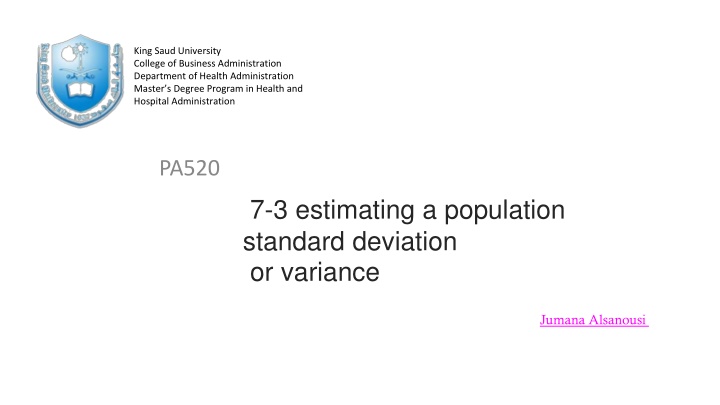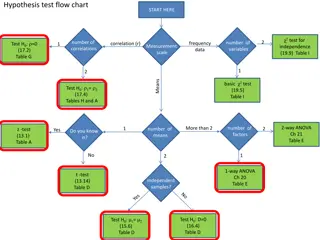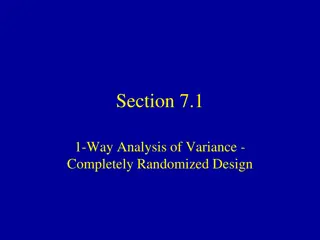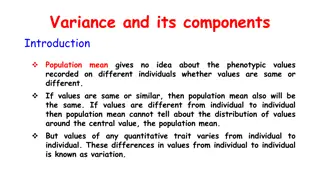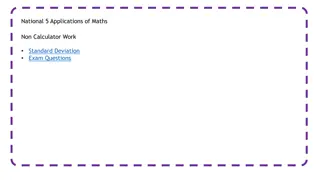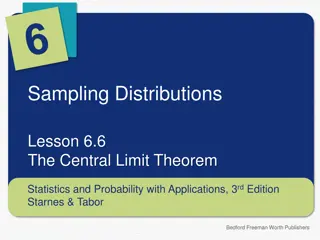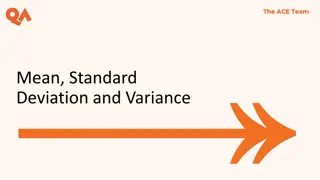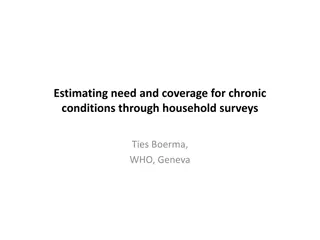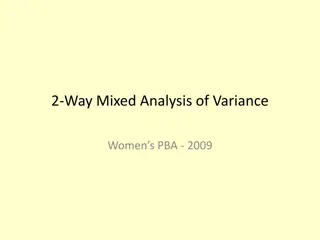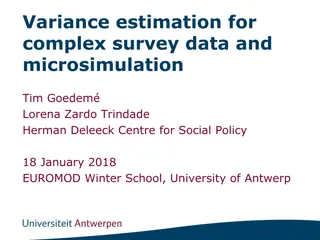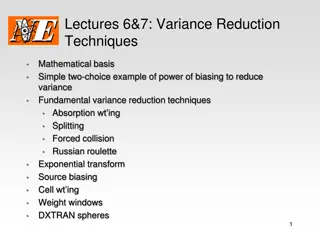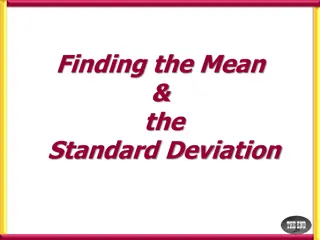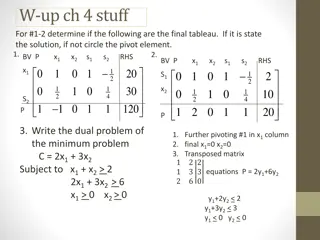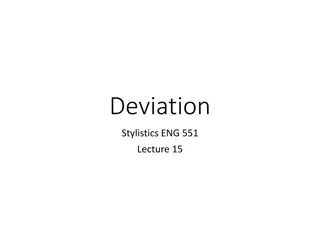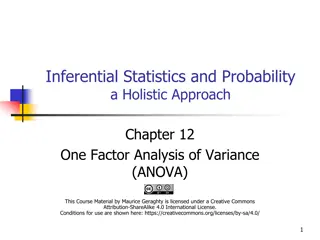Estimating Population Standard Deviation or Variance in Health Administration Programs
Overview of estimating population standard deviation or variance in health administration programs, including key concepts like point estimates and confidence intervals. Explains critical values of chi-square distribution and provides examples for better understanding.
Download Presentation

Please find below an Image/Link to download the presentation.
The content on the website is provided AS IS for your information and personal use only. It may not be sold, licensed, or shared on other websites without obtaining consent from the author.If you encounter any issues during the download, it is possible that the publisher has removed the file from their server.
You are allowed to download the files provided on this website for personal or commercial use, subject to the condition that they are used lawfully. All files are the property of their respective owners.
The content on the website is provided AS IS for your information and personal use only. It may not be sold, licensed, or shared on other websites without obtaining consent from the author.
E N D
Presentation Transcript
King Saud University College of Business Administration Department of Health Administration Master s Degree Program in Health and Hospital Administration PA520 7-3 estimating a population standard deviation or variance Jumana Alsanousi
7-3 estimating a population standard deviation or variance: Key concept Point Estimate: The sample variance s2 is the best point estimate of the population variance The sample standard deviation s is the best point estimate of the population standard deviation Confidence Interval: When constructing a confidence interval estimate of a population standard deviation ( or population variance), we construct the confidence interval using the 2 distribution This section presents methods for estimating apopulation variance and standard deviation .
7-3 estimating a population standard deviation or variance: R 2 Critical Value of x2: denote aright tailed critical value by And a left critical value : those value can be found from table -A and the require the value of degree of freedom degrees of freedom = n 1 L 2
Chi-Square Distribution Key Points about 2 In a normally distributed population with variance 2 assume that we randomly select independent samples of size n and, for each sample, compute the sample variance s2 (which is the square of the sample standard deviation s). The sample statistic 2 (pronounced chi-square) has a sampling distribution called the chi-square distribution. 2= (n 1)s2 2
Example: Finding critical values of x2 A simple random sample of ten voltage levels is obtained. Construction of a confidence interval for the population standard deviation requires the left and right critical values of 2 corresponding to a confidence level of 95% and a sample size of n = 10. Find the critical value of 2 separating an area of 0.025 in the left tail, and find the critical value of 2 separating an area of 0.025 in the right tail. Solution : with a sample size n = 10, number of degree of, df = n- 1 = 9
Example Critical Values of the Chi-Square Distribution
Example For a sample of 10 values taken from a normally distributed population, the chi-square statistic 2 = (n 1)s2/ 2 has a 0.95 probability of falling between the chi-square critical values of 2.700 and 19.023. Instead of using Table A-4, technology (such as STATDISK, Excel, and Minitab) can be used to find critical values of 2. A major advantage of technology is that it can be used for any number of degrees of freedom and any confidence level, not just the limited choices included in Table A-4.
Confidence Interval for Estimating a Population Standard Deviation or Variance = population standard deviation s = sample standard deviation n = number of sample values L 2 = left-tailed critical value of 2 2 = population variance s2= sample variance E = margin of error R 2 = right-tailed critical value of 2
Confidence Interval for Estimating a Population Standard Deviation or Variance Requirements: 1. The sample is a simple random sample. 2. The population must have normally distributed values (even if the sample is large).
Confidence Interval for Estimating a Population Standard Deviation or Variance Confidence Interval for the Population Variance 2 n 1 ( )s2 n 1 ( )s2 2 2 R L 2
Confidence Interval for Estimating a Population Standard Deviation or Variance Confidence Interval for the Population Standard Deviation n 1 ( )s2 n 1 ( )s2 2 R L 2
Procedure for Constructing a Confidence Interval for or 2 1. Verify that the required assumptions are satisfied. 2. Using n 1 degrees of freedom, refer to Table A-4 or use technology to find the critical values 2R and 2Lthat correspond to the desired confidence level. 3. Evaluate the upper and lower confidence interval limits using this format of the confidence interval: n 1 ( )s2 R n 1 ( )s2 2 2 L 2
Procedure for Constructing a Confidence Interval for or 2 - cont 4. If a confidence interval estimate of is desired, take the square root of the upper and lower confidence interval limits and change 2 to . 5. Round the resulting confidence level limits. If using the original set of data to construct a confidence interval, round the confidence interval limits to one more decimal place than is used for the original set of data. If using the sample standard deviation or variance, round the confidence interval limits to the same number of decimals places.
Confidence Intervals for Comparing Data Caution Confidence intervals can be used informally to compare the variation in different data sets, but the overlapping of confidence intervals should not be used for making formal and final conclusions about equality of variances or standard deviations.
Round-Off Rules for Confidence Intervals Used to Estimate or 2 1. When using the original set of data, round the confidence interval limits to one more decimal place than used in original set of data. 2. When using the summary statistics(n, s), round the confidence interval limits to the same number of decimal places used for the sample standard deviation.
Example: cofidence interval for estimating of volatage level The proper operation of typical home appliances requires voltage levels that do not vary much. Listed below are ten voltage levels (in volts) recorded in the author s home on ten different days. These ten values have a standard deviation of s = 0.15 volt. Use the sample data to construct a 95% confidence interval estimate of the standard deviation of all voltage levels. 123.3 123.5 123.7 123.4 123.6 123.5 123.5 123.4 123.6 123.8
Example: Step 1 requirement check Requirements are satisfied: simple random sample and normality
Example: n = 10 so df = 10 1 = 9 Use table A-4 to find: L 2= 2.700and R 2=19.023 Construct the confidence interval: n = 10, s = 0.15 ( R 10 1 ( )0.15 ( 19.023 )s2 n 1 ( )s2 2 )0.15 ( 2.700 n 1 2 L 2 ) 10 1 ( ) 2 2 2
Example: Evaluation the preceding expression yields: 0.010645 2 0.075000 Finding the square root of each part (before rounding), then rounding to two decimal places, yields this 95% confidence interval estimate of the population standard deviation: 0.10 volt 0.27 volt. Interpretation Based on this result, we have 95% confidence that the limits of 0.10 volt and 0.27 volt contain the true value of .
Determining Sample Sizes The procedures for finding the sample size necessary to estimate 2 are much more complex than the procedures given earlier for means and proportions. Instead of using very complicated procedures, we will use Table 7-2. STATDISK also provides sample sizes. With STATDISK, select Analysis, Sample Size Determination, and then Estimate St Dev. Minitab, Excel, and the TI-83/84 Plus calculator do not provide such sample sizes.
Example: We want to estimate the standard deviation of all voltage levels in a home. We want to be 95% confident that our estimate is within 20% of the true value of . How large should the sample be? Assume that the population is normally distributed. From Table 7-2, we can see that 95% confidence and an error of 20% for correspond to a sample of size 48. We should obtain a simple random sample of 48 voltage levels form the population of voltage levels.
